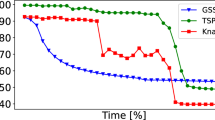Abstract.
Diffracting trees are an effective and highly scalable distributed- parallel technique for shared counting and load balancing. This paper presents the first steady-state combinatorial model and analysis for diffracting trees, and uses it to answer several critical algorithmic design questions. Our model is simple and sufficiently high level to overcome many implementation-specific details, and yet as we show it is rich enough to predict empirically observed behaviors accurately. As a result of our analysis we were able to identify starvation problems in the original diffracting tree algorithm and modify it to a create a more stable version. We were also able to identify the range in which the diffracting tree performs most efficiently, and the ranges in which its performance degrades. We believe our model and modeling approach open the way to steady-state analysis of other distributed-parallel structures such as counting networks and elimination trees.
Similar content being viewed by others
Author information
Authors and Affiliations
Additional information
Received October 1996, and in final form July 1997.
Rights and permissions
About this article
Cite this article
Shavit, N., Upfal, E. & Zemach, A. A Steady State Analysis of Diffracting Trees . Theory Comput. Systems 31, 403–423 (1998). https://doi.org/10.1007/s002240000095
Issue Date:
DOI: https://doi.org/10.1007/s002240000095




